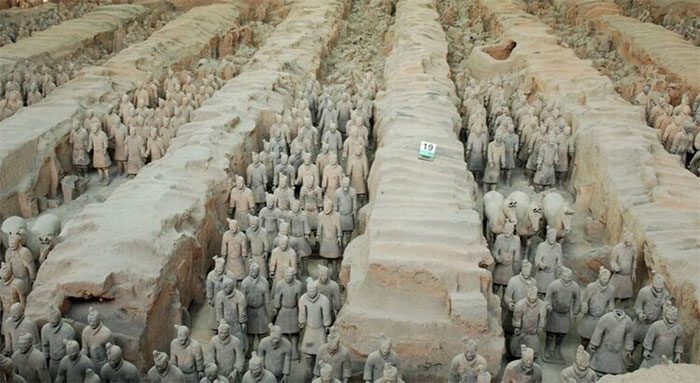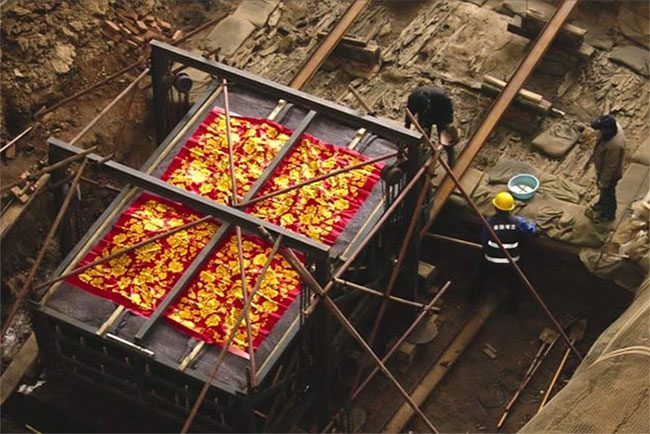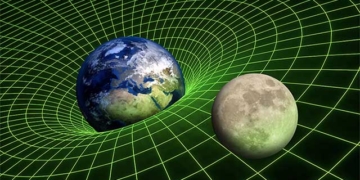A recent archaeological discovery has captivated the international scientific community, revealing a burial chamber filled with treasures hidden among the warriors of the Terracotta Army in China.
In Shaanxi Province, China, archaeologists have unveiled previously unknown details about the burial customs and treasures of the Qin Dynasty, particularly pertaining to the elite and royal family members.
The artifacts discovered demonstrate the richness and complexity of ancient civilizations, highlighting the importance of protecting the royal family members with previously unknown weapons and showcasing the significant role of the military.
A Tomb Filled with Wealth Hidden Among Thousands of Warriors

The Terracotta Army in the tomb of Emperor Qin Shi Huang (Photo: Science et Vie).
The Chinese government is increasingly keen to explore the Xi’an area (Shaanxi), home to the tomb of Emperor Qin Shi Huang , to uncover the mysteries of the Terracotta Army and other buried historical artifacts. This archaeological work aims to preserve the cultural and historical heritage of China.
Previously, in 2010, excavations focused on the foundations of the tomb revealed a massive palace with 18 houses arranged around a central hall, and nearby excavations uncovered a mysterious burial chamber containing valuable artifacts: a gigantic coffin weighing 16 tons.
These artifacts indicate a level of sophistication and wealth rarely seen compared to other tombs of the same era. Archaeologists also discovered ritual objects and weapons.
They believe that the deceased was a person of significant social and military importance. This may be Prince Cao, the son of Emperor Qin Shi Huang. This figure is constructed from legends and traditions, as recorded by Sima Qian.
An Important Historical Figure Protected by the Army
According to historical records, Prince Cao played a crucial role in the Qin Dynasty court. He significantly contributed to the expansion of the empire’s territory. The Qin Dynasty was founded by Emperor Qin Shi Huang in 221 BC.
This prince is also known for numerous administrative and military reforms. During this period, the construction of the Great Wall and the establishment of the Terracotta Army took place—those tasked with protecting the emperor as he transitioned to the afterlife.

Coffin and many valuable artifacts discovered in a mysterious burial chamber among the Terracotta Army (Photo: Science et Vie).
Recent excavations have revealed inscriptions and personal items potentially belonging to Prince Cao. According to Sima Qian’s records, after the death of Emperor Qin Shi Huang, his youngest son, Hu Hai, ascended the throne by slaughtering his brothers.
Prince Cao expressed to Hu Hai his regret for not willingly joining his father in the afterlife. He requested to die and be buried in the tomb alongside his father, and Hu Hai granted this request.
However, the story of Prince Cao may be entirely fictional. Although the Records of the Grand Historian by Sima Qian serves as a historical chronicle, it presents legends as facts, much like Livy’s history of Rome, Ab urbe condita, according to Archeonews.
The records describe the tomb as having 100 rivers of mercury flowing through it, which seems exaggerated but is not entirely fabricated. Soil tests have shown mercury levels here to be 100 times higher than normal.
The Significance of the Terracotta Army During the Qin Dynasty
The Terracotta Army consists of thousands of life-sized soldier statues designed to protect Emperor Qin Shi Huang in the afterlife. Each statue is sculpted with unique features that reflect the military organization and diversity of the army during that period.
The warriors are lined up in pits near the emperor’s tomb, accompanied by terracotta horses and chariots. They illustrate the military might of the Qin Dynasty. This magnificent collection was discovered in 1974 and has since become the subject of extensive research, symbolizing the craftsmanship and dedication to funerary practices during the Qin era.
The recent discovery of an elaborately decorated burial chamber among the statues adds a new aspect to our understanding of this army.
Until now, many believed that the Terracotta Army was created solely to protect Emperor Qin Shi Huang in the afterlife. However, the presence of the tomb believed to belong to Prince Cao here suggests that these statues also served to protect other important members of the royal family.
Many similar tombs may also be discovered, which will provide new insights into burial customs and beliefs during the Qin Dynasty. The discovery has highlighted the importance of the Terracotta Army, emphasizing its multifunctional role in protecting the elite of the Qin Dynasty as they transitioned to the afterlife.
This discovery also enhances our knowledge of the social structure and hierarchy of that time, underscoring the role of royal family members in managing and safeguarding the empire.




















































